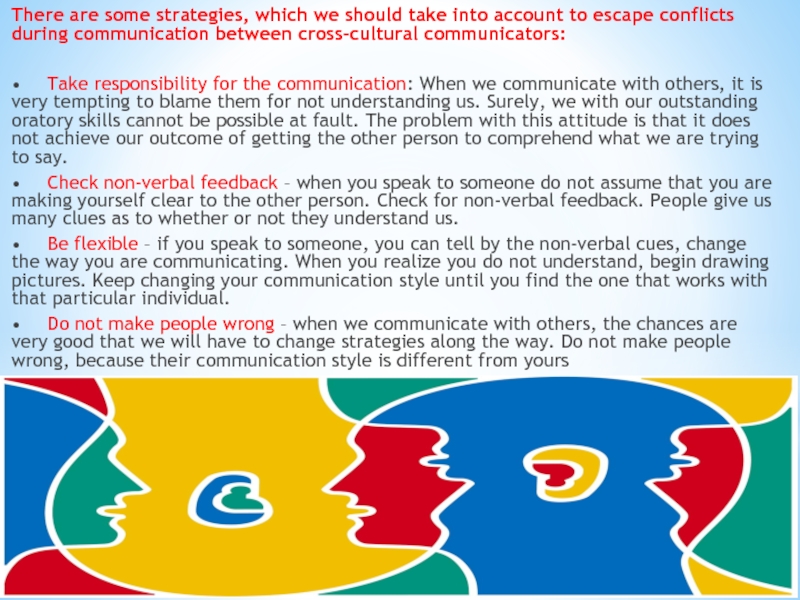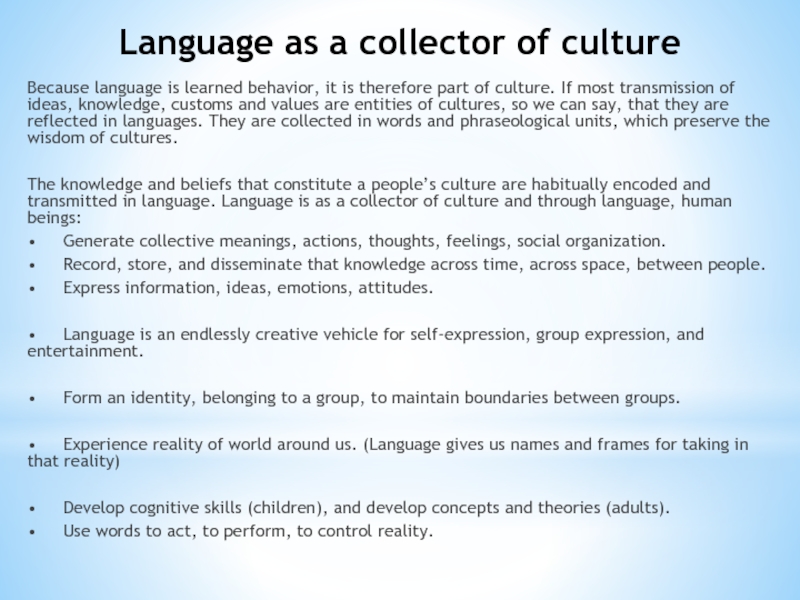Слайд 11. Language as the most important symbolic aspect of culture.
2. Language and thinking.
3. Cultural
thought patterns behind the language of communication.
4. Language as a collector of culture.
Interaction Between Language And Culture
Слайд 3Language as the most important symbolic aspect of culture
Language does not
exist in isolation; language is a part of culture. Language and culture are at the core of all human society.
Language is a symbolic system through which people communicate and through which they transmit culture. It contains the smallest units of sound that make a difference in meaning.
We define language as a system of communication using sounds and/or gestures, which are put together according to certain rules, resulting in meanings that are intelligible to all who share that language.
Слайд 4Language symbols allow people to develop complex thoughts and to exchange
those thoughts with others, to express one's ideas and feelings.
People may use one symbol, such as a single word, to represent many different ideas, feelings, or values.
Language and other forms of symbolic communication, such as art, enable people to create, explain, and record new ideas and information.
Linguists have found that although language is generally flexible and adaptable, established terminologies do tend to perpetuate themselves, reflecting and revealing the social structure and worldview of groups and people. For example, American English has a wide array of words having to do with conflict and warfare. It also features an abundance of militaristic metaphors, such as “conquering” space, “fighting” the “battle” of the bulge, carrying out a “war” against drugs, making a “killing” on the stock market, “shooting down” an argument, “torpedoing” a plan, “spearheading” a movement, “decapitating” a foreign government, or “bombing” on an exam, to mention just a few.
Слайд 5
Proverbs and sayings of one language are symbolic aspects of culture,
they demonstrate, shape and determine this or that cultural identity and dictate the rules and behavior codes for this very nation. For example, there would be little doubt that the following sayings are distinctly American:
-Time is money.
First come, first served.
Get to the point.
Lost time is never found again.
One today is worth two tomorrow.
Here today, gone tomorrow.
Eastern cultures do not appreciate haste and fast-paced life, either. For instance, the Japanese would advise: When in a hurry, take the roundabout route. The more haste - the less speed.
If the American culture presupposes that everyone has equal rights and possibilities, and their motto is: “We hold those truths to be self-evident, that all men are created equal,” in high-context cultures, which are hierarchical and traditional societies, the concepts of shame and honor are much more important. The Chinese value of hierarchy and power is well expressed in the proverb: “When you are an anvil, hold still. When you are a hammer, strike at will”.

Слайд 6Language and thinking
Moreover, a language both reflects and affects a culture's
way of thinking, and changes in a culture influence the development of its language.Language is more than just a means of communication. It influences our culture and even our thought processes. Language provides us with many of the categories we use for expression of our thoughts, so it is therefore natural to assume that our thinking is influenced by the language, which we use.
People try to find answers to the questions whether we think in language, whether creatures without language can "think", and the way language shapes our concepts. Speech begins in the brain. The size and complexity of the brain allows complex speech.
Слайд 7There are two main questions:
1)Is language acquisition a product of nature
or nurture?
2)Which comes first – language or thought?
Common sense tells us that language is a useful tool for expressing thought, but that it is not necessary. Thus, child-development researchers have found that young children understand concepts before they have words to explain them and that they can assign objects to categories even when they do not have the relevant vocabulary.
Слайд 8Cultural thought patterns behind the language of communication
In order to communicate
effectively across cultures, you need to understand the cultural thought patterns behind the language of communication.
The way we think equally depends on culture, and it is influenced by the culture.
Different cultures are distinguished by various thought patterns.
What is a thought pattern? A thought-pattern expresses the interaction of a number of concepts. It represents a way to think about the underlying subject matter.
The most obvious example of a thought pattern is provided by language itself. As a thought-pattern, our language shapes our way of thinking in more ways than we could ever express. It influences how we hear information presented.
Слайд 9In 1966, Robert B. Kaplan introduced his cultural thought patterns approach
based on contrastive rhetoric holds that people in different cultures organize their ideas differently.
English – (includes Germanic languages such as German, Dutch, Norwegian, Danish, and Swedish) portrayed by Kaplan graphically as an arrow. This style of communication may be viewed by other cultural groups as abrupt or inappropriate.
Semitic – (for example, Arabic or Hebrew) Thoughts are expressed in a series of parallel ideas, both positive and negative. Coordination is valued over subordination.
Oriental – (Languages of Asia) Communication is indirect, portrayed by Kaplan as a spiral. A topic is not addressed, but viewed from various perspectives working around and around the point. Largely, Asian communication is listening centered; the ability to listen (and a special talent for detecting various communicative cues) is treated as equally important as, if not more important than, the ability to speak.
Слайд 11There are some strategies, which we should take into account to
escape conflicts during communication between cross-cultural communicators:
• Take responsibility for the communication: When we communicate with others, it is very tempting to blame them for not understanding us. Surely, we with our outstanding oratory skills cannot be possible at fault. The problem with this attitude is that it does not achieve our outcome of getting the other person to comprehend what we are trying to say.
• Check non-verbal feedback – when you speak to someone do not assume that you are making yourself clear to the other person. Check for non-verbal feedback. People give us many clues as to whether or not they understand us.
• Be flexible – if you speak to someone, you can tell by the non-verbal cues, change the way you are communicating. When you realize you do not understand, begin drawing pictures. Keep changing your communication style until you find the one that works with that particular individual.
• Do not make people wrong – when we communicate with others, the chances are very good that we will have to change strategies along the way. Do not make people wrong, because their communication style is different from yours

Слайд 12Language as a collector of culture
Because language is learned behavior, it
is therefore part of culture. If most transmission of ideas, knowledge, customs and values are entities of cultures, so we can say, that they are reflected in languages. They are collected in words and phraseological units, which preserve the wisdom of cultures.
The knowledge and beliefs that constitute a people’s culture are habitually encoded and transmitted in language. Language is as a collector of culture and through language, human beings:
• Generate collective meanings, actions, thoughts, feelings, social organization.
• Record, store, and disseminate that knowledge across time, across space, between people.
• Express information, ideas, emotions, attitudes.
• Language is an endlessly creative vehicle for self-expression, group expression, and entertainment.
• Form an identity, belonging to a group, to maintain boundaries between groups.
• Experience reality of world around us. (Language gives us names and frames for taking in that reality)
• Develop cognitive skills (children), and develop concepts and theories (adults).
• Use words to act, to perform, to control reality.

Слайд 13Language is both part of culture as well as the medium
by which culture is defined and described. Stories, fairy tales, legends, humor, jokes, sayings, proverbs and idioms collect and preserve culture, the wisdom of nations, their customs and ways of life.
Language is a collector of culture. To prove this, let us consider English phraseological units, and especially idioms. They are like a drop in the ocean of English culture that reflects its significance throughout history. English is a language particularly rich in idioms – those modes of expression peculiar to a language (or dialect) that frequently defy logical and grammatical rules. There are at least 25,000 idiomatic expressions in the English language.
Слайд 14Idiom (Latin: idioma, “special property”, f. Greek: δίωμα – idiōma, “special
feature, special phrasing”) is an expression, word, or phrase that has a figurative meaning that is comprehended in regard to a common use of that expression that is separate from the literal meaning or definition of the words of which it is made. Sources of idioms:
1. from our everyday life
• to be born with a silver spoon in one’s mouth
• to sail under false colour (прятать истинное лицо)
• to loose track of smb (потерять кого-либо из виду, давно не видеть)
• a leopard can(’t) change its spots
2. from the Bible
• Ex.: black sheep, lost sheep (заблудшая овца)
• To cast pearls before swine (метать бисер перед свиньями)
3. World literature
• to fight against Windmills
• an ugly duckling (Danish) (гадкий утенок)
4. different languages
• to lose face (Chinese)
• “The course of true love has never run smooth” Shakespeare “The 12th night”
5. from history
• to cross the Rubicon
• Labours of Hercules
• To bell the cat